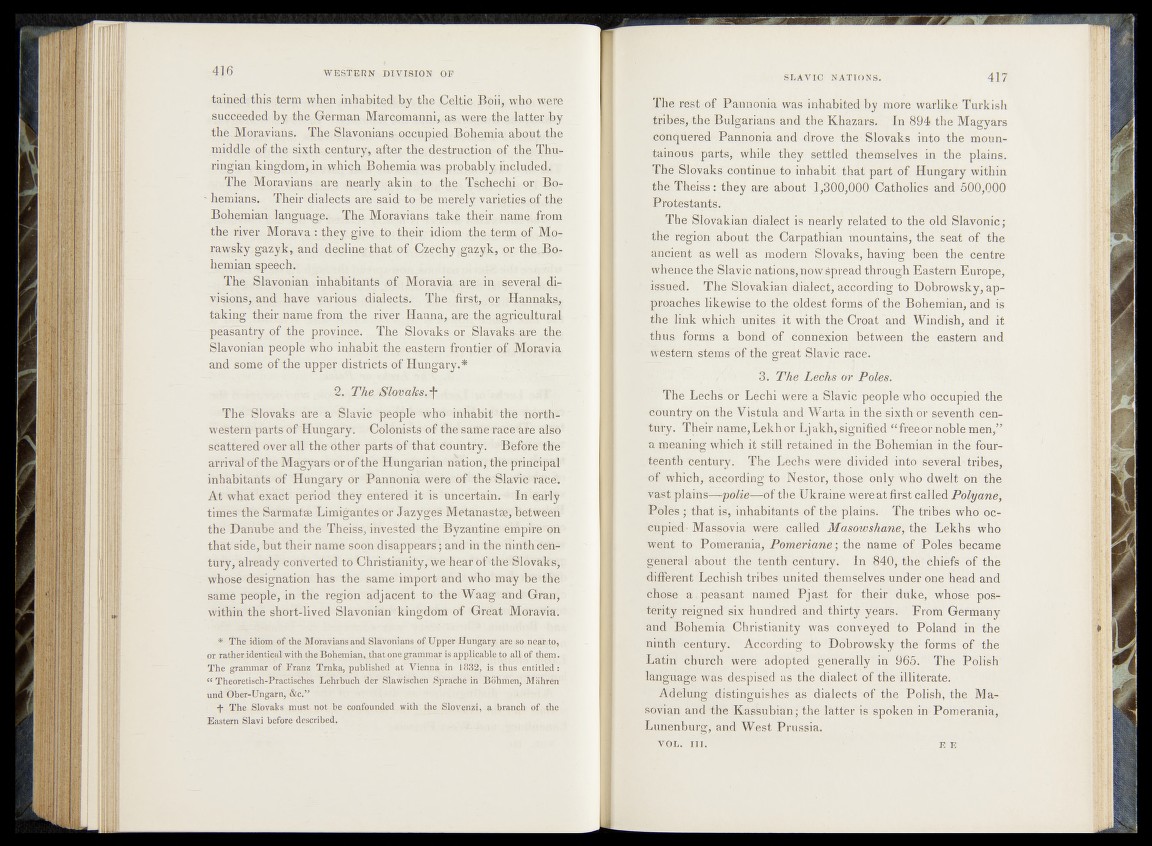
tainedthis ferm w^en^h"aJ?ite<J|*^ Celtic B©i%, who, wei^
ss96|^ée4l»-3l the German Marcomanni, as ;wore.f|i%!flf ttey.by
the. M o ^ ay ii^ T ^ evoniap^ -,ogcapie(J^phpmi a; apf$4fth;p
mid4le of th.è sjxiffccot^ry» aftejs tKgt4eat;r.aGti the Thu-
ringian kingdom, in, which Bohemig. lyas^pp^p^bly p^clqdep*.; :
: ,The. Mo|aviansj: are nearly, ak iri j't^ th jf s Tsj^ecj^i, orf Bo-
' hemians. Their dialects are said to be merely -yarj|||ie§ƒ>£thf
Bohemian kmgnagp|, The MoraviansJ^-ke. tpeiv;uame^Ji|orn
the giyft, to, their idiom the term of Morawsky.
gazyk, and decline; that*pp, Czechy^azyk, pr theJ3p-
hemian speech.
... The. Slavonian inhabitants -of Moravja f&^in.;; §ever§|.s divisions,
a n d . hay§ various,, dialects*:. The
feking their name .from the river Hanna,, aje,.tlm^gri^il|u^af
- peasantry p f the provmee, Th^,.Slovaks,‘. o i ^ l | y ^ s ^ e ^ e ,
Slavonian people who inhabit the,eastern frontjej^of Moravia,
and some of the upper districts of Hungary.*
. 2r The S hw a k s ,^ ^ -
The Slovaks are a Slavic people who inhabit?the fïéft-hr’
western parts of Hungary. Colónists O# ÉïeisttSIgf aÉé€fe a©#
scattered over all the Other parts o f “ that * d&iMtry l Befblglh#
arfivälof the Magyars or of the Hungarian nation, the principal
inhabitants ofHungary or Pannonia wCfe-of- thé#la##f®CUS
At what‘exact period theylÄteriM itris uneirtain^^ - in daM^
timesthe Sarmat.se Limigantes or JazygiS MetanaSt^betwePm
the Danube and the Theiss, invested the^Byzsentine Empire on‘
that side, but their name soon disappears ; and in the n in th b ü ^
ttify, already Converted to Christianity, Wëdïeaï* Of^the^Blóvaksiï
whose designation has thé same' imporktnid' who^'ÄwIy jkfêtëTOltl
same people, in the region adjacent to the Waag and Gran,
within the short-lived Slavonian* kingdom of Great- Moravia.
* The idionr of the Moravians and Slavonians of Üpper Hungary are so near .to, j
or rath er identical with the Bohemian^lhatone grammar is applicabletqall of them, i
Thè grammar of Franz Trnka, published at Viennain- 1832, is thus entitled:
“ Theoretisch-Practisches Lehrbuch der Slawischen Sprache in Böhmen,“ Mähren
und Ober-Ungarn, &c.”
-f- The Slovaks must not be confounded with the Slovenzi, a branch of, the
Eastern Slavi before described.
The rest of Pannonia was inhabited by more warlike Turkish
tribes, the Bulgarians and the Khazars. In 894 the Magyars
conquered Pannonia and drove the'Slovaks into the moun-
tainou smarts,’ while, ^h^y settled! themselves in the plains.
The #lovaks.iConrinue to inhabit that part of Hungary within
the Theiss: they are about J,BOO,000 Catholics and 500,000
PrqtCstants.
The Slovakian dialect^is nearly related to the old Slavonic ;
.the region about the Carpathian mountains, the seat of the
afleieht as well ras modern Slovaks, having been the centre
whence the Slavic nations, now Spread through Eastern Europe,
issued/ The'Slovakian dialect, according to Dobrowsky, approaches
likewise to the oldest forms of the Bohemian, and is
the link which’ unites it with the Croat and Windish, and it
. thus forms a bofid of connexion between the eastern and
wfestern stems of the great' Slavic race.
3. The Lechs or Poles.
The Lechs.'or Lechi were a SlaWc people who occupied .the
i'C“cm*ntry oh .the Vistula and Warttuin tfie sixth or seventh century.
Their name, Lekhor Lj akh, signified,-^ free or noble men,”
a meaning which it still retained in the Bohemian in the four-
.fceenth century. The Lechs were'divided into several-tribes,
of which, according to Nestor, those- only who dwelt on the
vast plains—poife—of the Ukraine were at first called Polyane,
Poles ; that is, inhabitants of the plains/' The tribes who occupied’
Massovia were called Masowshane, the Lekhs who
went to Pomerania, Pomeriane; the name of Poles became
general about the tenth century. In 840, the chiefs of the
different Lechish tribes’ united themselves under one head and
chose a | peasant named Pjast for their duke, whose posterity
reigned six hundred and thirty years. From Germany
and Bohemia Christianity was conveyed to Poland in the
ninth century. According to Dobrowsky the forms of the
Latin church were adopted geherally’ in 965.' The Polish'
language was despised as the dialect of the illiterate.
A delung distinguishes as dialects of the Polish, the Ma-
sovian and the Kassub.ian; the latter ts spoken in-Pomerania,
Lunenburg, and West Prussia.